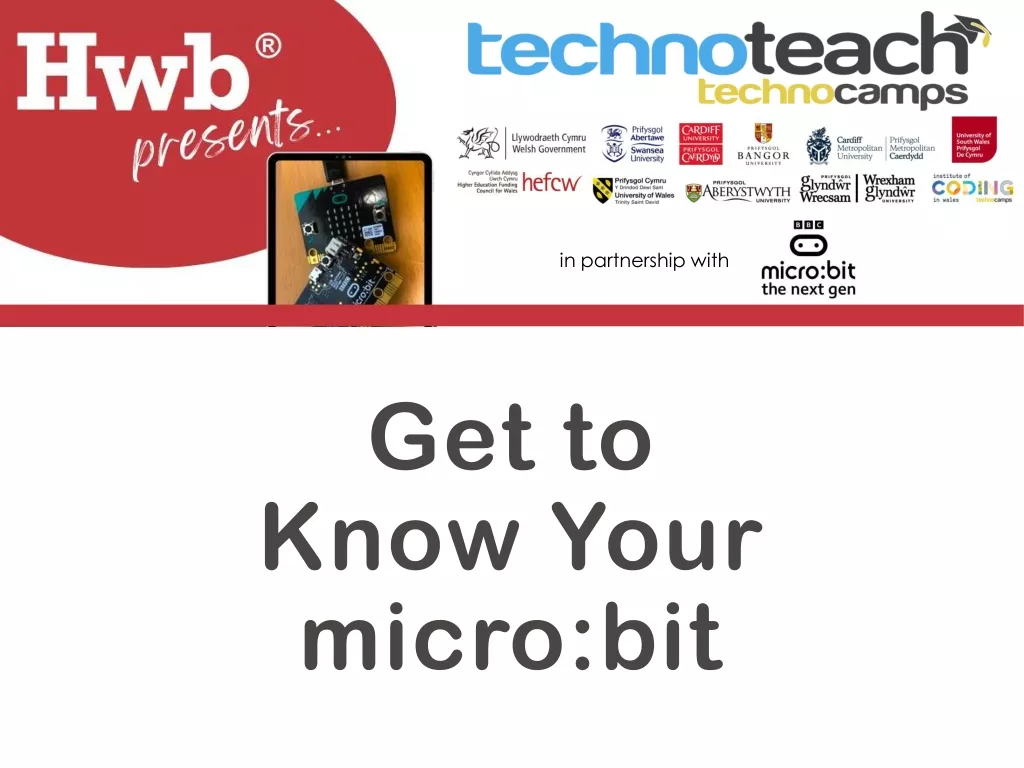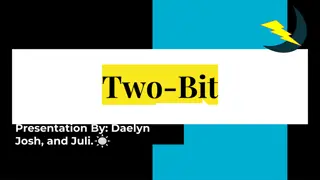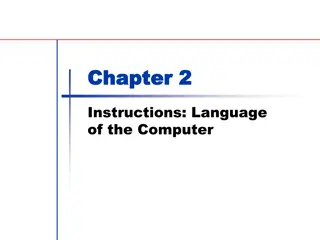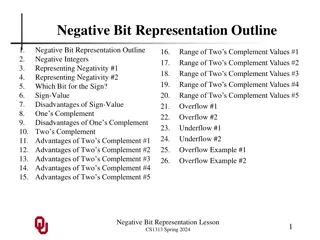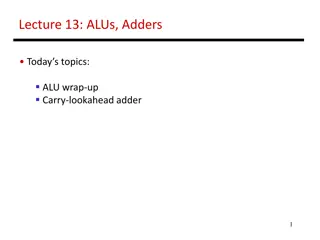micro:bit - The Next Gen Technocamps Partnership
Discover the collaboration between Technocamps and the micro:bit Foundation in Wales, bringing the new phase of micro:bit projects to students. Dive into what micro:bit can do, explore coding with Makecode, engage in fun activities like Emotion Badge coding, and learn how to use button events to con
0 views • 30 slides
4-Bit Parallel Adder/Subtractor IC7483
Explore the concept of 4-bit parallel adder/subtractor using IC7483, which is a digital circuit capable of performing arithmetic operations on binary numbers greater than one bit in length. Learn about the structure, operation, and implementation of parallel adders with cascaded full adders. Discove
8 views • 11 slides
Discrete Mathematics
Explore the foundations of logic and proofs in discrete mathematics, focusing on compound propositions, bit operations, and applications of propositional logic. Learn about how computers use bits for information representation and manipulation, and delve into translating English sentences into logic
6 views • 15 slides
Daily current affairs 2024(presentation)
\u25ba Check this page for wide range of online courses: http:\/\/bit.ly\/kd-courses\n\nDo you want to get a Government job online course? Here are best govt job preparation courses :\n\n\ud83d\udc49 SSC Courses - \/\/bit.ly\/3Ft9FrY\n\n\ud83d\udc49 UPSC Courses - \/\/bit.ly\/3Diszjr\n\n\ud83d\udc49
2 views • 22 slides
SSC CHSL CPO 2024 (presentation)
\u25ba Check this page for wide range of online courses: http:\/\/bit.ly\/kd-courses\n\nDo you want to get a Government job online course? Here are best govt job preparation courses :\n\n\ud83d\udc49 SSC Courses - \/\/bit.ly\/3Ft9FrY\n\n\ud83d\udc49 UPSC Courses - \/\/bit.ly\/3Diszjr\n\n\ud83d\udc49
2 views • 9 slides
COMPUTER ORGANISATION Register Transfer Language
Register Transfer Language is a symbolic notation used to describe the micro-operations transferring data among registers in computer organisation. It signifies the availability of hardware logic circuits to perform specified micro-operations and transfer results between registers. Register Transfer
7 views • 7 slides
Character Sets in Computer Science
Alphanumeric characters, special symbols, and control characters play crucial roles in representing data through character sets like ASCII and Unicode in computer science. ASCII, with its 7-bit binary codes, represents 128 characters, while Extended ASCII allows for 256 characters. Unicode covers a
1 views • 12 slides
PowerPC Architecture Overview and Evolution
PowerPC is a RISC instruction set architecture developed by IBM in collaboration with Apple and Motorola in the early 1990s. It is based on IBM's POWER architecture, offering both 32-bit and 64-bit processors popular in embedded systems. The architecture emphasizes a reduced set of pipelined instruc
2 views • 13 slides
Create a Flood Warning System with Micro:bit and Moisture Sensor
A design brief for constructing a flood warning system using micro:bit to detect rising water levels and alert homeowners, aiming to mitigate damage caused by flooding. The project involves selecting suitable input sensors, such as a moisture sensor, and programming the micro:bit to trigger a warnin
3 views • 9 slides
Evolution of Microprocessors: A Historical Overview
The history of microprocessors traces back to Fairchild Semiconductors in 1959, leading to the founding of Intel in 1968. The evolution from 4-bit to 64-bit microprocessors by Intel revolutionized computing. Key milestones include the Intel 4004 and 4040 (4-bit), 8008, 8080, and 8085 (8-bit), and th
5 views • 44 slides
Memory Design Overview: SRAM Cell and Bit Slice Organization
This content provides an overview of SRAM (Static Random Access Memory) cell and bit slice organization, explaining the design elements such as SRAM cell augment, D latch tristated output, multiple enable signals, row and bit selection, data input and output, addressing, and memory expansion with mu
0 views • 25 slides
IEEE 802.11-19/0468r0 RSTA Requires ISTA-to-RSTA LMR Bit
This document proposes adding a bit in the Extended Capabilities element to indicate if ISTA needs information from RSTA for 11az negotiation initiation. It suggests RSTA advertise its expectation for ISTA to share the Location Measurement Report. By setting the RSTA requires ISTA-to-RSTA LMR bit, R
2 views • 11 slides
The Life and Personality of Two-Bit Matthews in "The Outsiders
Two-Bit Matthews, a key character in "The Outsiders," is described as the wisecracker of the gang with a humorous and loyal personality. Standing at six feet tall, with gray eyes and a wide grin, he is known for his optimistic nature, love for jokes, and loyalty to his Greaser friends. Despite his s
0 views • 5 slides
Computer Organization and Design: Chapter 2
This content discusses shift operations, AND operations, OR operations, EOR operations, and conditional operations in computer organization and design. It covers topics such as shifting logical operations, masking bits, including bits, differencing operations, and conditional branching instructions,
0 views • 22 slides
Micro:bit Robot Entry Tutorial - Lesson on Tracking with YahBoom
Explore the world of robotics with this comprehensive tutorial series focused on tracking using YahBoom in micro:bit. Learn about black line tracking, infrared sensor principles, hardware setup, and block programming to enhance your robotics skills. Follow step-by-step instructions to create a fun a
1 views • 12 slides
Do-more Technical Training: Coil/Bit Output Instruction Set
Learn how to utilize the Coil/Bit Output Instruction Set in Do-more Technical Training. This set covers various functionalities including Unconditional END, Trailing Edge One-Shot, Output Reflection, Leading Edge One-Shot, Push On/Push Off, and Reset operations. Understand how each instruction works
0 views • 11 slides
Micro:bit Robot Entry Tutorial with YahBoom - Buzzer Singing Lesson
In this engaging tutorial series, you will learn how to program a micro:bit robot to sing "Happy Birthday" using a buzzer. Follow step-by-step instructions to set up your micro:bit, connect it to your computer, search for coding blocks, and combine them to create a musical robot. Powered by YahBoom,
3 views • 8 slides
Improved Encryption Technique for Phase Change Memory (PCM)
Bit flips in Phase Change Memory (PCM) can adversely impact performance, power consumption, and system lifespan. To address this, a write-efficient encryption scheme called DEUCE was developed, which reduced bit flips by 50% and improved speed by 27%. By re-encrypting only modified data, the scheme
0 views • 41 slides
Micro:bit Quiz Counter Prototype Development
Developing a score counter prototype using micro:bit for quiz participants. The product aims to accurately track and display team scores, catering to young adults with a durable and portable design. Pre-written programs in JavaScript and Python editors are provided for easy implementation on BBC mic
0 views • 5 slides
Developing an Automatic Lighting System with micro:bit
Explore how to save lighting energy with the micro:bit by developing a programmable system for automatic lighting in homes. The project involves using sensors to detect motion, LED lights for illumination, and programming the micro:bit to control the lighting based on occupancy in the room. Get hand
0 views • 8 slides
Bit Masking and Bitwise Operations for Efficient Bit Manipulation
Bit masking is a powerful technique in programming to selectively access or modify specific bits without affecting others. By creating a byte with bits set at desired positions using a bit mask, bitwise operators like OR (|) and AND (&) can be leveraged to efficiently set or clear specific bits. Thi
0 views • 11 slides
Negative Bit Representation in Computer Science
Dive into the world of negative bit representation in computer science, exploring the need for representing negativity in integers, methods like Two's Complement, disadvantages of Sign-Value and One's Complement, range of Two's Complement values, overflow, underflow, and more. Discover the significa
0 views • 26 slides
Carry Bit Calculation in Digital Systems
Explore the concepts of carry bit calculation in digital systems through re-examination of addition operations, generating carries, propagating carries, and scenarios where Cout must be zero. Discover how different combinations of Ak and Bk values influence the carry bit and learn about situations w
0 views • 12 slides
ALUs and Adders in Computer Architecture
Explore the concepts of Arithmetic Logic Units (ALUs) and adders in computer systems through topics like ALU operations, 1-bit ALU with Add, Or, And operations, 32-bit Ripple Carry Adder, subtraction incorporation, NOR and NAND operations, control lines for different operations, incorporating slt an
0 views • 19 slides
Non-Optimal Routing and 32-Bit ASN Compatibility
Explore the challenges caused by the incompatibility of 32-bit ASN with old router software, leading to non-optimal routing issues. Learn about Autonomous Systems, AS Numbers, BGP asymmetric routing, and the importance of routing software supporting 32-bit ASN. Discover how outdated software replace
0 views • 8 slides
Micro:bit Robot Entry Tutorial - Advanced Lesson on Breathing Lamp with YahBoom (80 characters)
In this tutorial, learn how to create an advanced breathing lamp effect using a micro:bit robot with YahBoom. Follow the steps to program the colorful lights on the dot matrix, change colors of the seven-color lamp, and connect the micro:bit to a computer for programming. This comprehensive guide in
0 views • 13 slides
MIPS Arithmetic Logic Unit (ALU)
The MIPS ALU is the heart of computer calculations, performing functions like add, and, or, and sub. This article delves into designing a full ALU, starting from a 1-bit full adder to a 32-bit ALU. It explores how operations like and, or, and addition are carried out within the ALU, and how to imple
0 views • 28 slides
Emerging Variable Precision Formats in Compiler Flow
Many applications rely on floating point numbers, but deciding on the right precision is crucial to avoid performance and energy waste. This work explores the impact of precision choices, including overkill and insufficient precision, on applications such as CNNs and GPU algorithms. It introduces a
0 views • 25 slides
Privacy Address Requirements for Wireless Personal Area Networks
This document discusses the privacy address requirements for IEEE P802.15 Working Group's TG4ab standard for Wireless Personal Area Networks (WPANs). It covers the need for 48-bit addresses with collision resistance, the use of different privacy addresses for each frame, and the adequacy of 12-bit c
0 views • 8 slides
Creating a Musical Instrument Using BBC Micro:bit
Design and program a device using the BBC Micro:bit to be used as a musical instrument in a class performance. The project involves creating different parts of a piece of music such as rhythm, harmony, and melody, and includes criteria for the device's functionalities like producing drumbeats, playi
0 views • 14 slides
Micro:bit Robot Ultrasonic Obstacle Avoidance Tutorial
Learn how to set up and program a micro:bit robot for ultrasonic obstacle avoidance. Follow the step-by-step guide to prepare hardware, connect the micro:bit to the computer, search for programming blocks, and test the ultrasonic sensor. Children can understand the concepts and experiment with obsta
0 views • 10 slides
Programming the micro:bit Robot Buggy for Maze Navigation
In this project, teams work together to program a micro:bit-powered robot buggy to successfully navigate a maze layout. The program development involves testing at different intervals before the final attempt. Participants need to meet the design brief and criteria by programming the BBC micro:bit u
0 views • 5 slides
Illustrated Design of a Simplified CPU with 16-bit RAM
Demonstrates the design of a basic CPU with 11 instructions and 4096 16-bit RAM, showcasing the assembly of a general-purpose computer using gates and registers. The CPU comprises 8 key registers for various functions, employing a sequential circuit for instruction execution. The machine language pr
0 views • 31 slides
The Simplified Instructional Computer - Overview of SIC Machine
The Simplified Instructional Computer (SIC) consists of the standard model and the XE version, each with distinct features. The SIC Machine memory, registers, data formats, addressing modes, instructions, and I/O operations are detailed, providing insight into its functioning. Integers are stored as
0 views • 44 slides
micro:bit Basic Lesson: Good Morning, Good Night
In this micro:bit tutorial, learn to display a sun or moon pattern based on light intensity. Connect the micro:bit board to your computer, search for programming blocks, and set intermediate values for custom displays. Complete the course with a fun learning experience.
0 views • 9 slides
Bridging 64-bit MACs in IEEE 802.1
This content delves into bridging challenges between 64-bit MACs and 48-bit MACs in IEEE 802.1 standards, emphasizing issues like address format incompatibilities, MAC frame formats, adaptation, and routing protocols. It discusses scenarios for bridging in PAN networks and the complexities in addres
0 views • 13 slides
The Future of iOS and macOS is 64-bit
Apple's transition to 64-bit apps, ending support for 32-bit apps on macOS and iOS devices. Implications for developers and users, timeline for changes, and the impact on app availability. Details on Apple's policies, store updates, and guidance for the transition. Information on macOS Mojave and th
0 views • 25 slides
Microprocessor - 8085
The 8085 Microprocessor, designed by Intel, is an 8-bit programmable integrated device with computing and decision-making capabilities similar to a computer's CPU. It features a 16-bit address bus, 8-bit data bus, program counter, stack pointer, and six 8-bit registers. Operating at 3.2 MHz with a +
0 views • 12 slides
Intel 8086 Microprocessor Architecture Overview
The Intel 8086 microprocessor is a 16-bit processor with a 20-bit address bus capable of accessing up to 1MB of memory. It features 14, 16-bit registers, multiplexed address, and data bus, segmented memory architecture, and dedicated units for instruction execution and bus interface. Learn about its
0 views • 40 slides
Toggle-Aware Compression for GPU Systems
Data compression can reduce bandwidth pressure, but it also increases energy costs due to bit toggles. Toggle-Aware Compression Energy Control (EC) and Metadata Consolidation (MC) aim to mitigate this issue. This approach reduces bit toggles, maintaining performance benefits. The importance of energ
0 views • 26 slides
